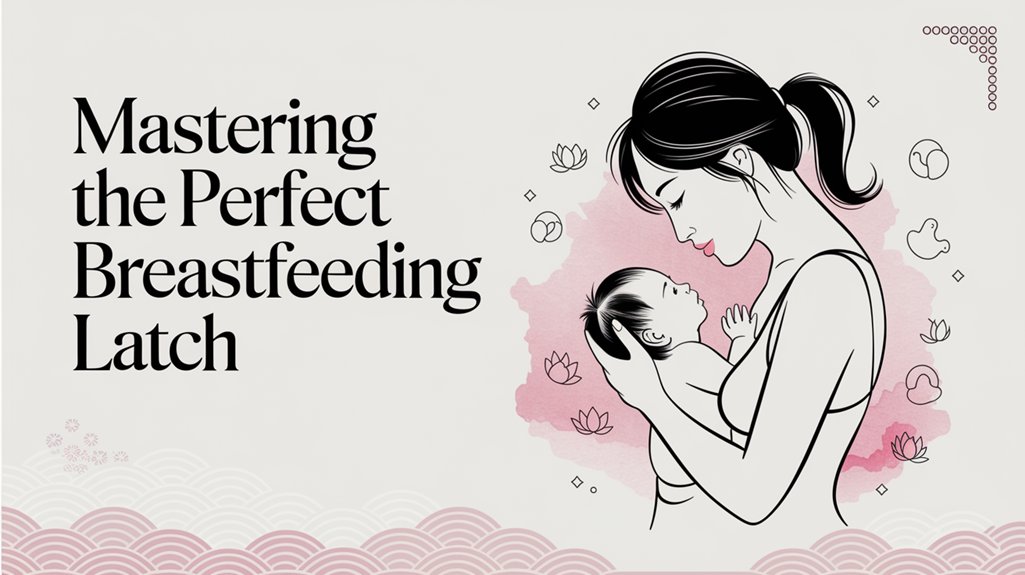A good breastfeeding latch, often referred to as a baby latch, occurs when your baby takes the right amount of breast tissue into their mouth, allowing for effective milk transfer without causing nipple pain. Many mothers struggle with latching issues, which can lead to sore nipples, poor milk supply, and feeding difficulties. This comprehensive guide explains step-by-step latching techniques, solutions to common challenges, and practical tips to help you and your baby master the perfect latch for comfortable and successful breastfeeding.

Understanding the Basics of a Good Latch
A good breastfeeding latch occurs when your baby takes not just your nipple but a large portion of the areola (the darker skin surrounding your nipple) into their mouth. When your baby latches correctly:
Your baby’s mouth is open wide, similar to a yawn
Your baby’s lips are flanged outward (not tucked in or looking like “fish lips”)
Your baby’s chin touches your breast
Your baby’s nose is close but not pressed against your breast
Little or no areola is visible from below the baby’s lower lip
You can hear or see your baby swallow after several sucks
Proper nipple positioning is critical—when the baby latches, the nipple should aim for the roof of the baby’s mouth. This placement allows your baby to compress the milk sinuses with their tongue and gums, resulting in effective milk transfer.
Getting a Good Latch
Remember, there is no single correct way to start breastfeeding. As long as your baby latches well and both of you are comfortable, the approach you take is up to you.
Create a calm environment first. Recline on pillows or another comfortable area. Choose a place where you can feel relaxed and at ease.
Hold your baby skin-to-skin. Hold your baby, wearing only a diaper, against your bare chest. Place the baby upright between your breasts and simply enjoy this bonding time without immediate pressure to breastfeed.
Let your baby lead. If your baby isn’t hungry, they’ll stay curled against your chest. A hungry baby will bob their head, attempt to make eye contact and move around more actively. Learn to recognize these hunger signs.
Support your baby, but don’t force the latch. Gently support their head and shoulders as they search for your breast. Resist the urge to push them onto the nipple.
Allow your breasts to hang naturally. When your baby’s chin touches your breast, this pressure signals them to open their mouth wide and reach over the nipple. As they press their chin into the breast and open wide, they should achieve a deep latch. Remember that babies can breathe while at the breast—their nostrils flare to allow air in.
Additional Latching Techniques
Proper Breast Support
Support your breast with your free hand using the “C-hold” or “U-hold”:
Place your thumb on top of your breast and your fingers underneath, keeping them behind the areola
This technique helps direct your nipple and positions your breast at the baby’s mouth level
Avoid pressing too hard, which can block milk ducts
Positioning Your Baby

Hold your baby close with their body facing yours (tummy-to-tummy)
Position your baby’s head at nipple level, with their nose aligned with your nipple
Allow your baby’s head to tilt slightly back, creating a straight line from ear to shoulder
Support your baby’s shoulder blades rather than pushing on the back of their head
Encouraging a Wide Latch
Brush your nipple against your baby’s upper lip to prompt them to open their mouth wide.
Wait until your baby’s mouth opens wide like a yawn
Bring your baby to your breast quickly but gently
Aim your nipple toward the roof of your baby’s mouth
Ensure your baby takes a large portion of the areola into their mouth, with more areola visible above their upper lip than below their lower lip
Common Latching Challenges and Solutions
Shallow Latch
A shallow latch occurs when the baby’s latch is not deep enough, causing the baby to suck only on the nipple instead of taking a good portion of the areola. This causes nipple pain and inefficient milk transfer.
Solutions:
Gently break the suction by inserting your clean finger into the corner of your baby’s mouth
Reposition and try again, ensuring your baby’s mouth opens wider
Try the “flipple” technique: compress your breast slightly and guide more areola into your baby’s mouth after the initial latch
Flat or Inverted Nipples
Flat or inverted nipples can make latching more difficult but not impossible. Improper latching with flat or inverted nipples can also lead to sore or cracked nipples.
Solutions:
Try breast compression just before latching
Use a manual pump briefly before feeding to draw out the nipple
Consider using breast shells between feedings
In some cases, a nipple shield may help, but consult a lactation specialist first
Tongue-Tie Check
If your baby continues to have trouble latching or isn’t gaining weight properly, check for tongue-tie—a condition where the tissue connecting the tongue to the floor of the mouth restricts movement.
Signs of possible tongue-tie:
Difficulty extending the tongue past the gums
Heart-shaped or notched tongue when extended
Inability to lift the tongue to the roof of the mouth
Persistent nipple pain despite correct positioning
A healthcare provider or lactation consultant can diagnose and recommend treatment if necessary.
The Impact of Positioning on Latching
Different breastfeeding positions can significantly affect your baby’s ability to latch properly:
Cross-Cradle Hold
This position gives you excellent control of your baby’s head and is particularly helpful for newborns and when learning to latch:
Hold your baby across your body, supporting their head in the crook of your arm opposite to the breast you’re feeding from
Use your free hand to support your breast
Laid-Back Breastfeeding (Biological Nurturing)
This position leverages gravity and natural reflexes:
Recline comfortably on your back (not flat)
Place your baby on your chest, allowing them to use their natural instincts to find the breast
This position often helps babies latch more deeply and can reduce nipple pain
Side-Lying Position
Excellent for nighttime feeds or when sitting is uncomfortable:
Lie on your side with your baby facing you
Position your baby’s mouth at nipple level
Support your baby’s back to maintain alignment
The key to any position is ensuring your baby’s head is slightly tilted back to facilitate easier nursing and swallowing.
Skin-to-Skin Benefits for Latching

Skin-to-skin contact before breastfeeding helps babies connect with their instinctive breastfeeding skills:
Place your baby wearing only a diaper against your bare chest
Allow your baby to find the breast naturally, which often results in a better latch
Practice skin-to-skin regularly, not just during feeding times
This approach activates your baby’s feeding reflexes and increases oxytocin, which helps with milk flow
Troubleshooting Latch Problems
Signs of Poor Latch and Insufficient Milk Transfer
Clicking sounds during feeding
Dimpling of cheeks while sucking
Minimal swallowing
Fussiness or frustration at the breast
Poor weight gain
Frequent feeding without satisfaction
Sore or damaged nipples
Baby not getting enough milk, leading to frequent feeding without satisfaction
Breaking and Re-latching Techniques
When you notice signs of a poor latch:
Gently insert your clean index finger between your baby’s gums to break the suction
Remove your baby from the breast completely
Re-centre and try again, ensuring a wide mouth and proper positioning
Be patient—it may take several attempts to achieve a good latch
Adjusting Techniques
Breastfeeding techniques may need adjustment during the early weeks:
What works in the first few days might change as your milk supply increases
Your baby’s mouth grows, and their sucking pattern develops
Monitor and adapt your approach based on comfort and effectiveness

When to Seek Professional Support from a Lactation Consultant
Contact a lactation consultant if you experience:
Persistent nipple pain that doesn’t improve after the first week
Cracked or bleeding nipples
Baby not gaining adequate weight
Difficulty maintaining a latch
Concerns about milk supply
Engorgement or blocked ducts
If nipple pain worsens after the early days of breastfeeding, it may indicate other issues like thrush or undiagnosed tongue-tie that require professional assessment.
Consequences of a Poor Latch and Nipple Pain
Understanding the importance of a good latch can motivate you to seek help when needed:
For the baby:
Inadequate milk transfer leads to poor weight gain
Dehydration
Failure to thrive
Frustration and fussiness
For the mother:
Nipple trauma (cracks, blisters, bleeding)
Blocked ducts and mastitis
Decreased milk supply
Premature end to breastfeeding due to pain
Getting Professional Help
Breastfeeding specialists provide valuable support through various challenges:
Lactation Consultants (IBCLCs) are healthcare professionals with specialized training in breastfeeding management. They can:
Observe feeds and suggest specific adjustments
Diagnose and help resolve latching issues
Provide personalized care plans
Offer evidence-based advice
Breastfeeding Medicine Specialists are physicians with advanced training in human lactation who can:
Diagnose medical conditions affecting breastfeeding
Prescribe medications when necessary
Perform procedures like tongue-tie release
Address complex breastfeeding challenges
Final Thoughts
Remember that breastfeeding is a learned skill for both you and your baby. Most latching challenges are temporary and can be overcome with patience, practice, and sometimes professional guidance. Trust yourself and your baby to find what works best for you both.
While the first few weeks may require frequent adjustments to your technique, a good latch will eventually become second nature. The investment in establishing proper latching pays off with comfortable, effective breastfeeding that benefits both you and your baby.
If you’re experiencing persistent latching difficulties, don’t hesitate to reach out to a certified lactation consultant. Their expertise can make a significant difference in your breastfeeding experience and success. Our team of experienced lactation consultants is ready to provide personalized support and guidance—contact us today to schedule a consultation and transform your breastfeeding journey.








